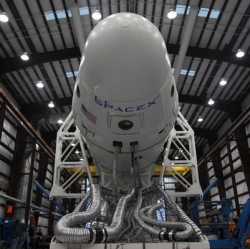
The SpaceX Falcon 9 rocket launched successfully on a cargo delivery run for NASA bound for the Space Station. The mission also had an objective aimed at eventually recovering the rocket’s first stage via the use of landing legs.
Marking a first of its kind test, this 20 story tall commercial Falcon 9 rocket was equipped with a quartet of landing legs to test controlled soft landing techniques first in the ocean and then back on solid ground at some later date this year or next, by reigniting the 1st stage engines for a guided touchdown.
The 12 foot diameter Falcon 9 rocket would sprout the legs just prior to water impact for the controlled soft landing in the Atlantic Ocean, guided by SpaceX engineers. Prior to the launch SpaceX managers were careful not to raise expectations.
“The entire recovery of the first stage is completely experimental,” said Hans Koenigsmann, SpaceX vice president of mission assurance. “It has nothing to do with the primary mission.”
He estimated the odds of successfully retrieving an intact booster at merely 30 or 40 percent.
Following Friday’s blastoff, SpaceX reported they made significant strides towards that goal of a 1st stage recovery.
